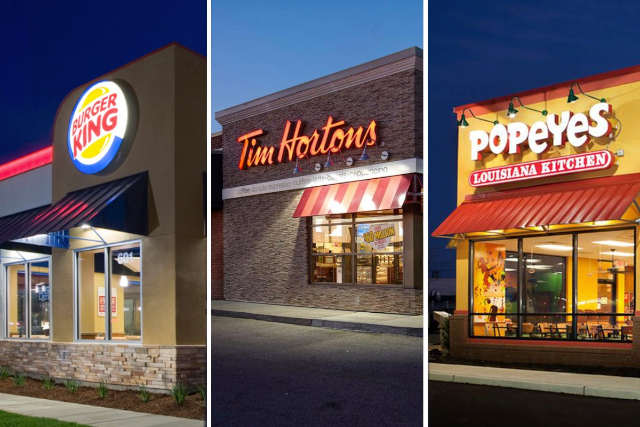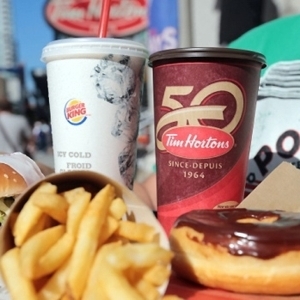A couple of weeks back we noted that several Fast Food chains were making big changes in the wake of the COVID-19 crisis – permanently closing hundreds of locations and re-jigging their business models to ensure that they can survive in a post-pandemic world where folks will be eating differently…
 Another major player in the Fast Food Brand consolidation
Another major player in the Fast Food Brand consolidation
game is pulling in its tentacles under pressure
due to the COVID-19 pandemic…
Back on July 27, we passed on the news that Dunkin’s and McDonald’s will definitely be closing permanently their satellite locations, in Speedway gas stations and Walmart department stores respectively, as part of a broader response to Things They’ve Learned during the Summer of 2020 COVID lock down crisis.
Now, Restaurant Brands International (RBI), the holding company that owns and operates Tim Horton’s, Burger King and Popeye’s Louisiana Kitchen, has revealed its intention to do the same thing. Except that RBI has offered some additional details about its plans that help the rest of us understand where this apparently desperate trend is actually going.
More of a shift than shrinkage
Thought McD’s and Dunkin’s framed their closures simply as shedding dead weight by closing low-traffic locations to save on operating costs, RBI explains that, while that was one of its motivations in earmarking hundreds of its locations worldwide for closure, it has carry-on plans that will see its brands, “end 2020 with a similar number of restaurants relative to where we ended 2019.”
RBI CEO José Cil spoke extensively to shareholders and the media during RBI’s quarterly financial conference call late last week.
The idea, he explained, is to close under-performing stores and shift their resources to new locations where they’ll do better. RBI is expected to open about the same number of new locations this year as it closes. It will also update locations that the head office deems need a boost in their décor and service models.
“…We are going through a proactive process of looking through our systems all around the world, and where it makes sense to close restaurants that will help improve the overall health of the system profitability,” RBI’s CFO Matt Dunnigan explained. “[That] makes sense for our partners and for us in terms of the business models and supporting future development. That’s something we’re going to do, and we’re going to be proactive about that in the second half [of 2020].”
The key thing to look at here, I think, is that even though Dunnigan and Cill admitted their renewal program has been accelerated in the face of pressures brought by the COVID-19 crisis, such changes were already in the works before the pandemic came along earlier this year. And the current coronavirus-spurred disruption in their traditional business model has simply been brought forward. Trust a billion-dollar, multi-national corporation to frame a potential disaster as an ‘opportunity’…
So, the inevitable shakeout is upon us
I, for one, think that the RBI brands will be closing significantly more stores than they open, or re-open this year. And I’m convinced that will go for McD’s and Dunkin’s and other chains that have been looking for a way to make big changes to their business and service models, and streamline their operations in general.
McDonald’s for one started a couple of years ago to update its décor and ordering process with more comfortable ‘home-like’ surroundings and automated selection, payment and fulfillment systems. While it’s always a tricky, risky thing to bring in major changes of any kind in a successful business model, especially when times are to be good – or at least appear to be to the outside observer – a cataclysmic disruption such as the COVID-19 crisis offers excellent camouflage for such moves.
Have you been listening to the subtler messages the Fast Food industry has been sending? “Who knows what the quick-service resto world will look like once the pandemic blows over?” they say, preparing us for any changes, no matter how dramatic, they might want to institute. In spite of, or in convenient concert with temporary changes in their service protocols, many brands have been suggesting that they may stay with their COVID-19 mandated slimmed down menus after the crisis is over. They make no bones about admitting that such a move will help simplify operating routines – and cut costs. And they’ve been hitting us all really hard with sales pitches for their new or expanding online or mobile ordering and payment systems, which will help them cut their service counter staff and infrastructure costs even further.
My take
I started prognosticating about a landscape-changing business model shift in the Fast Food sector a few years back. Then, I thought it would involve the collapse of many local one-off joints and smaller regional chains, and the merger of some mid-level chains under the umbrellas of the large, first-rank and multinational brands.
Another phenomenon I predicted was the refocusing of the top brands under their ‘original’ identities (i.e.- Burgers, Chicken or Tex-Mex), and ending their expensive and largely unsuccessful forays into neighbouring sectors. Okay. Many of the big players are, in fact, talking about staying with their COVID-19 streamlined menus after the pandemic is over. It’s one thing the head offices and their franchisees and front-line operators have been able to agree on lately. However, this could be bad news for consumers who would suffer from restricted menus and restricted brand choice. On the other hand, I don’t see a lot of major mergers – except among the ‘Burger’ joints, of which there are many, and of which some are bound to either fail or merge eventually under pressure from increasingly refocused the global brand leaders.
One thing I didn’t count on was the congregation of smaller, mid-sized brands under holding companies such as RBI so they could all focus on their core identities and still benefit from larger, group-buying and promotion schemes. This development potentially allows the smaller brands to survive – and even thrive – in regions where they are held in high esteem by fans. This is, generally, good for brand diversity and consumer choice.
One thing is certain: the grand shakeout in the Fast Food sector is far from over. It will be intriguing to watch it unfold further over the next decade…
~ Maggie J.

